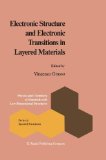

 |

|

The average rating for Electronic Structure and Electronic Transitions in Layered Materials based on 2 reviews is 3 stars.
Review # 1 was written on 2014-10-17 00:00:00 Janelle Mcdermid Janelle McdermidNot terribly exciting. I don't know if it was the book, my mood, or that states of matter just isn't an exciting topic. I felt like I was getting a lot of extra information that I didn't really need. This was my least favorite book in this series, but it was still fine. I'll use it with the fifth graders next year. |
Review # 2 was written on 2014-12-08 00:00:00 Joe Kuhn Joe KuhnAs a grand evolutionary synthesis, this book by Chaisson does a fine job; a fine job that is, if your definition of "grand" excludes mind, consciousness, interiority, experience, and everything that is NOT matter, energy, space, and time (physics, chemistry, biology). Chaisson gives us an outstanding review of what's currently understood as the big picture of evolution in the realms of the natural sciences, a kind of updated version of similar books from 1980s systems theory such as Laszlo's Evolution: The Grand Synthesis and Jantsch's The Self-Organizing Universe: Scientific and Human Implications. And as a physicist-astronomer, he can be forgiven for focusing solely on the third-person-objective-materialist aspects of human experience since, well, since that's what he's trained to do (focus here, ignore there). If you want a book that defines "grand evolutionary synthesis" there's no better place to go than the books of Ken Wilber (despite their shortcomings), a synthetic genius who takes all of what Chaisson presents and couples it with the co-evolution of interiority, mind, and consciousness (see his Sex, Ecology, Spirituality: The Spirit of Evolution). Wilber's synthesis is vast and brings together huge areas of human knowledge that have hitherto been separate such as western developmental psychology, eastern nondual philosophy, postmodern intersubjective perspectives, complex systems theory, states of consciousness research, and more. Wilber's work however has suffered from charges of teleology, over-emphasis on hierarchical levels, reliance on a contemporary version of the Great Chain model, and a lot of writing not grounded in careful research, referencing, and scholarship. But so much of Wilber's work is hugely valuable, if only his distinction of the difference between "cosmos" and "Kosmos", the former being what Chaisson is talking about, i.e., the material cosmos only, and the latter, Kosmos, what Wilber writes about which includes four interrelated, interdependent aspects of evolution: the objective organism, the subjective mind, the interobjective environment, and the intersubjective culture. Probably the best and most careful work on synthesizing the interior/mind and exterior/matter aspects of evolution is the work by the embodied mind cognitive science folks who are also incorporating complex systems theory into their work such as Francisco Varela, Evan Thompson, Andy Clark, Alva Noe, Alicia Juaerro, Daniel Hutto, Shawn Gallagher, Terrance Deacon, and many others (see my Embodied Cognition listopia list for more ). Thompson's book Mind in Life: Biology, Phenomenology, and the Sciences of Mind is an outstanding contribution to a view that can truly be called "grand synthesis," a view that incorporates subjective phenomenological first-person experience with objective third-person knowledge of biological systems organization. For a (slightly technical) romp through the materialist version of the evolutionary grand synthesis, Chaisson delivers admirably. But for those of us who can't ignore interiority, consciousness, and first-person perspectives in our view of grand synthesis I suggest digging into the literature on embodied mind cognitive science, particularly the enactive approach pioneered in the Varela-Thompson-Rosch's The Embodied Mind: Cognitive Science and Human Experience. |
CAN'T FIND WHAT YOU'RE LOOKING FOR? CLICK HERE!!!